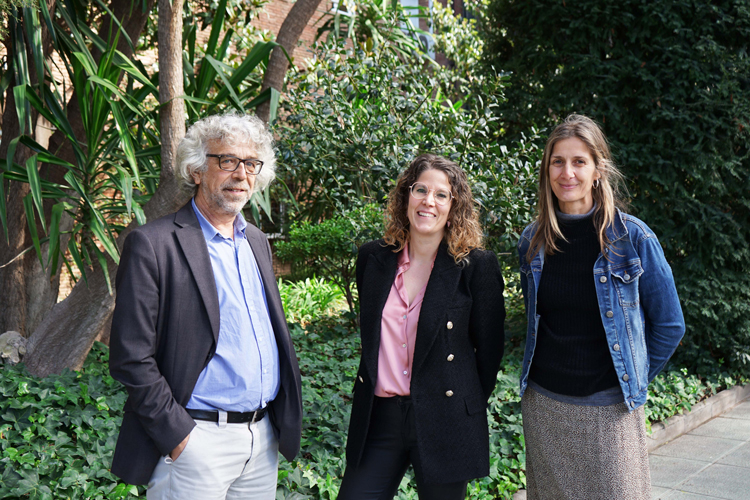Dr. Mireia Castejón recently defended her doctoral thesis at IQS, where she has managed to obtain the tetrasaccharide compound lacto-N-tetraose, present in breast milk, by enzymatic synthesis. This opens the door to obtaining new biocatalysts for the synthesis of HMO oligosaccharides by this route.

Dr Antoni Planas, Dr Mireia Castejón, and Dr Magda Faijes
Breast milk provides numerous benefits to newborns, in particular due to the oligosaccharides known as HMOs (Human Milk Oligosaccharides). HMOs offer various biological functions that make them act as immunomodulatory prebiotics or pathogenic inhibitors, among other benefits. HMOs are present in breast milk with a unique and highly variable composition giving breast milk its own characteristics that are difficult to replace.
To date, more than 200 different HMO structures have been identified, and it is impossible to obtain them from natural sources. In addition, due to their high structural complexity, large-scale chemical synthesis of these carbohydrates remains a challenge as it requires numerous synthetic steps. As such, commercial infant formula only contains HMOs that have simple structures. Therefore, one of the great challenges in producing these types of formulas involves obtaining a product with properties that mimic breast milk to the greatest extent possible. Enzymatic synthesis is an interesting synthetic alternative for producing these compounds as, thanks to the enzymes, it makes it possible to control the stereoselectivity and regioselectivity of the oligosaccharide produced. Moreover, enzymatic synthesis is easy to transfer to an industrial process as it is a clean and environmentally friendly technology.
Within this context, Dr Mireia Castejón recently defended her doctoral thesis conducted with the Department of Bioengineering at the IQS School of Engineering, entitled "Breast milk oligosaccharides: a challenge for infant formula. Protein engineering of the lacto-N-biosidase enzyme of Bifidobacterium bifidum for the synthesis of lacto-N-tetraose”. Her thesis was supervised by IQS Department of Bioengineering full professor Dr Magda Faijes and tenured professor Dr Antoni Planas, both members of the Biological and Biotechnological Chemistry Group (GQBB).
Enzymatic synthesis of lacto-N-tetraose
One of the major HMOs present in breast milk is lacto-N-tetraose tetrasaccharide (LNT) and its fucosylated and/or sialylated derivatives. B.bifidum lacto-N-biosidase (LnbB), which belongs to the GH20 family of glycosyl hydrolases, is responsible for its hydrolysis through microbiota in the intestinal tract of newborns. In her research, Dr Castejón redesigned the LnbB in order to obtain an efficient biocatalyst for the production of the LNT through an enzymatic route.
Through the structural study of the negative subsites of the enzyme LnbB, the latter were redesigned using protein engineering methods to evaluate the synthesis of LNT employing the strategy of transglycosylation by kinetic control using activated glycoside donors. The amino acids involved in the binding and stabilizations of the donor molecule were selected and modified. After the selection and characterization of the different mutants, W394F – a tryptophan substituted by phenylalanine in the active centre of the enzyme – has shown to be the most effective, with an LNT obtaining yield of 32% in a single step.
Other mutations in the substrate binding site environment have also been explored using the BINDSCAN computational tool developed at the IQS Biochemistry Laboratory to assist in the in silico design of enzyme specificity. Although the efficiency in the synthesis of LNT is still moderate, this thesis project opens the doors to future research that is being conducted at IQS to obtain new biocatalysts for the enzymatic synthesis of HMOs.
This doctoral thesis has received funding within the project GLYCO2ZYMES BIO2013-49022-C2-1-R of the National R&D&i Plan of the Spanish Ministry of Science and Innovation.
Related publications
1. M. Castejón, M. Faijes, A. Planas, Trasnglycosilation activity of engineered bifidobacterium lacto-N-biosidase mutants at donor subsites for lacto-N-tetraose synthesis, Int. J. Mol. Sci. 2021, 22(6), 3230
2. M. Faijes, M. Castejón, C. Val, A. Planas, Enzymatic and cell factory approaches to the production of human milk oligosaccharides, Biotechnology Advances 37, 667–697 (2019)











